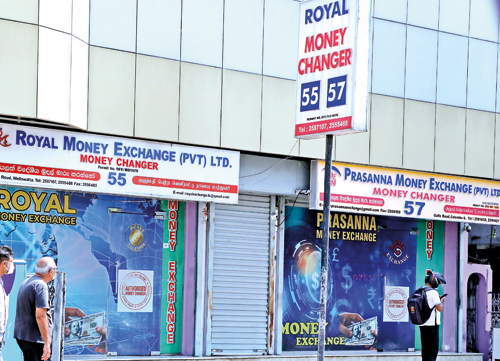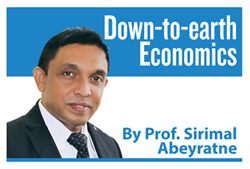Forex for “hand-to-mouth”
View(s):
Money exchange dealers in Colombo
Last Sunday “Raju” had sent me a text message with a brief note that surprised me. His name is Dr. Ramaraju Venuthurupalli – one of my Indian friends who retired recently after serving as a Professor of Economics at the University of Delhi. Although his brief surprised him and shattered all his imaginations about Sri Lanka, as we all know it is not a surprise to the Sri Lankans.
Here is part of a news report quotation on which Raju had commented in his note: ‘Hand-To-Mouth situation’ in Sri Lanka: Food and Fuel supplies run out. Food or Fuel? The Sri Lankan government is in a dilemma what to purchase first. It’s facing an acute shortage of both these essentials. It’s relying on loans to stay afloat. India has granted US$500 million more to help Colombo.”
He went on to draw some parallels from India: “India is currently sitting on record foreign exchange reserves, record food reserves, record fuel reserves, record arms reserves, and record pharma reserves…”
Then he posed his question to me: “Sirimal, I saw this post here today but refused to believe it as Sri Lanka has always been better off than us. Is it true? I hope it’s not!”
Well, although the public is used to hear confusing statements every day denying such a situation, the official facts and figures as well as our day-to-day life experience tell us that it’s true! I admitted the truth which must have raised his eyebrows.
Progressing in crisis times
Before I turn to the crux of the matter – the foreign exchange crisis, I must stress the fact that I too was fascinated by India’s progress even in the midst of a global health crisis. According to The Indian Express newspaper on January 25, 2022, the Indian economy is estimated to grow at 9.2 per cent in the current year 2021-2022 (Oct-Sep), although the rate is lower than the earlier estimate of 9.5 per cent. The rate of growth in India is now even higher than China. India has also become the fifth largest economy in the world, ousting the UK that has held that position so far.
According to India’s Department of Commerce, India has also set a $400 billion export target for the current year and the country has already recorded its highest ever exports in the first quarter of the current year (Oct-Dec), amounting to $95 billion. If the export target is realised, Indian export income will exceed Singapore’s as well.
Without strong export growth, it is impossible to sustain higher economic growth and, without foreign direct investment (FDI) it is impossible to achieve strong export growth. Having achieved $82 billion FDI inflows last year (2020-2021) and $73 billion in the previous year, India is anticipating a big FDI inflow this year as well.
The stock of foreign exchange reserves of the Reserve Bank of India is $635 billion by the beginning of 2022, whereas it was $400 billion two years ago. Apart from that it also has gold reserves amounting to 744 tonnes. Thus, the recorded increase in reserves of foreign exchange, food, oil and other, as quoted in Raju’s note is not an exaggeration.
It’s not COVID
The economic status and economic progress of India and many other countries in Asia have confirmed that it is not the COVID-19 pandemic that has caused Sri Lanka to fall down into a foreign exchange crisis and the resulting ‘hand-to-mouth’ situation. In fact, the pandemic has exposed the problem which has been a deep-rooted fundamental error in economic management.
 A country has to establish consistent foreign exchange inflows through export growth, while export growth also depends on FDI growth. In the last couple of weeks, in this column I have elaborated how Sri Lanka has failed sadly in both export growth and FDI growth. Sri Lanka’s exports account for $10 billion whereas imports account for as twice as its exports. And investors didn’t want to bring their money to Sri Lanka and hence our FDI flows remained poor.
A country has to establish consistent foreign exchange inflows through export growth, while export growth also depends on FDI growth. In the last couple of weeks, in this column I have elaborated how Sri Lanka has failed sadly in both export growth and FDI growth. Sri Lanka’s exports account for $10 billion whereas imports account for as twice as its exports. And investors didn’t want to bring their money to Sri Lanka and hence our FDI flows remained poor.
In the absence of export growth, Sri Lanka continued to depend on more borrowings than on investment, which took a grave turn in 2007. This year, the country opened the government securities to foreign lenders and turned to commercial borrowing as well through dollar-denominated sovereign bonds. As I explained in this column last week, Sri Lanka has borrowed $17 billion by issuing sovereign bonds for 12 years (2007-2019) while the country’s total FDI flows 40 years (1980-2020) amounted to less than $13 billion only.
Debt bunching up
It was this commercial borrowing with maturity periods of five and 10 years that has worsened debt servicing, because foreign debt obligations are now bunching up several times a year with $4 – 6 billion repayments every year.
The simple question is that how do we meet debt obligations a few times a year in the absence of export growth. It’s not a new problem that came out of COVID-19, but an old problem that has been overlooked for years and decades. If it was the political conflict that prevented the country undertaking reforms to improve the quality of policies and regulations in favour of export growth and FDI growth, the next question that we need to ask is why has the policy regime deteriorated further during the past 10 years.
The debt obligations have so far been met with the use of import controls adopted to save little amounts of dollars that the country has been earning and the use of foreign exchange reserves which declined to about $1 billion. Import controls and the new exchange regulations as well as the resulting negative impact on production, all have contributed to domestic supply shortages and rising inflation.
It is clear that all these measures are counterproductive multiplying the domestic economic crisis as transmitted from the foreign exchange crisis. The problem worsened during the past couple of weeks due to fuel shortages and electricity cut down, further reducing the productive capacity of the economy and causing further deterioration of investor confidence.
How to get out?
The authorities are at a policy dilemma as to where to spend foreign exchange – whether to pay debt or to buy fuel or food. And wherever it is, first they also need to find few more dollars from somebody – whether the multilateral lenders such as the IMF or the bilateral lenders – because even without more loans it is difficult to spend in any of these areas.
Apparently, the country needs to borrow further to stay afloat for some time. Of course, it doesn’t solve the problem; rather it would postpone it for few more months until it comes back later as a bigger problem! Even if it’s the case, a few more favourable thoughts floating around are the anticipated revival of tourism, increased remittances, a couple of asset sales and, some FDI flows which would bring about a few billions of dollars.
Even if these thoughts are worthy, how can the short-term solutions solve a long-term problem? They are all unlikely to push the economy out of the current impasse unless and until the fundamental issues are addressed through a medium-term reform agenda. The reforms are required to eliminate the regulatory barriers to export growth and FDI growth, to improve the business environment, to strengthen the public finance on both revenue and expenditure sides, to privatise or restructure the state enterprises and to eliminate corruption.
There is no doubt that the crisis time has given another golden opportunity to undertake a comprehensive reform programme. But I doubt whether the political will and capacity would be in favour of such a reform agenda to replace the current ad hoc and piecemeal patchworks.
(The writer is a Professor of Economics at the University of Colombo and can be reached at sirimal@econ.cmb.ac.lk and follow on Twitter @SirimalAshoka).
Hitad.lk has you covered with quality used or brand new cars for sale that are budget friendly yet reliable! Now is the time to sell your old ride for something more attractive to today's modern automotive market demands. Browse through our selection of affordable options now on Hitad.lk before deciding on what will work best for you!


